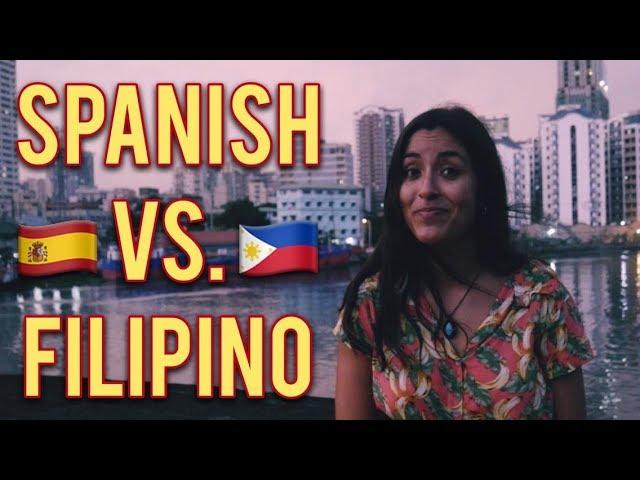
HOW SIMILAR ARE SPANISH AND FILIPINO ? SIMILITUDES ENTRE EL FILIPINO Y EL ESPAÑOL
Комментарии:

Hola
Ответить
Es una pena que se haya perdido el habla del idioma español en Filipinas, espero que se vuelva a hablar nuevamente
Ответить
I went to the Philippines in 2019 and went to my Mom's ancestral village. There was a woman there named Estrella. I asked her if she knew what her name meant. She didn't even know it was Spanish, much less the meaning of it.
There is a famous Filipino Martial Arts instructor. He teaches escrima. I went to visit his school years ago. He began to talk about the word "escrima" and said that it possibly means "skirmish".
He didn't know that it a spanish word - esgrima - which is the Spanish word for "fencing"

Filipinas, Morroco y Hispanoamérica la Trinidad española
Ответить
As a Filipino, I’m not sure what I feel about the sudden interest of these spanish vloggers to the Philippines and Filipinos. We weren’t taught in their history and we were just the backwater when Spain was ruling the Philippines. Why, is it because it gets them views?
Ответить
Appender Tagalog no es dificil yo aprendi en 3 meses
Ответить
CORECCION POR FAVOR !! ES TAGALOG Y NO TAGALO !! COMPRENDISTE ? GRACIAS Y QUEDATE LIBRE DE VIRUS CHINO !!!
Ответить
Hahhahaa gracias
quiero aprender español

A century ago, Spanish was the only official language. In fact, everyhing were written in spanish. Tagalog was just a dialect in the street. Tagalog was only recently elevated to Filipino official language in 1970's along with english and spanish. In theory, most college graduates could understand simple spanish at that time. It was only in 1986 that spanish was completely abolished in the constitution.
Ответить
The Philippines or Filipinas was a former colony of Spain for 336 years, not 333 which we could always see in History books or Wikipedia. Spanish and French were the main lingua franca back then. Americans came and enforced the USE of AMERICAN ENGLISH and they even changed our FIRST names into ENGLISH.
Ответить
In 1987, the Philippine Government abolished SPANISH because it was useless and should focus on IT, and in 2007- UP DILIMAN suggested THE TAGALIZED subject content or PURE FILIPINO and remove ENGLISH. THAT'S THE REASON WHY FILIPINOS ARE NOT FLUENT IN ENGLISH OR CAN'T SPEAK IN SPANISH.
Ответить
España no invadió filipinas , las unificó y creo conceptualmente. El Tagalo , se habla en la mayoría del archipiélago porque fue el idioma con que se decidió evangelizar, al ser el más numeroso y haber sido en Méjico mas fácil la evangelización en lenguas nativas.
Ответить
que ironico un ingles y una esañola juntos en filipinas....deverias saber la historia y entenderias lo que digo
Ответить
En Filipinas no se habla español hoy día porque en su día el castellano era el idioma de los colonos españoles y adinerados autóctonos que eran minoría minoría.. Es así de simple
Ответить
Chabacano (spanish dictionary):
Que es grosero, ordinario o de mal gusto.

Pls. Try to watch Do filipino speaks Spanish? Yes ! In t
Ответить
Well if you're ancestors didn't burn our culture including our language then you might expect difference
Ответить
Aaaaa, ahora entiendo todo, Vi una vez las candidatas de Filipinas en universo y todas tenían nombres latinos y como que hablaban español XD
Ответить
Lo mismo le paso a texas california Arizona que eran parte de Mexico yegaron los ingleses comandados por las grandes Elites pero gracias a los Mexicanos que recistieron el Español no desaparecio
Ответить
if you visit Zamboanga, there is a large Spanish speaking people there but they call their language "Chavacano" its sounds like almost Spanish
Ответить
......Filipino?
El idioma se llama Tagalo.

Year 60 we got 4levels of Spanish lesson in high school also in University Spanish 1_4. I think now a days no more.
Ответить
si par de pendejos, dejaron muuuuchas huellas en el pueblo filipino...
Ответить
Man I hope our government will bring back Spanish language in our country!!
Ответить
go to zamboanga
Ответить
The Philippines was a colony of Spain for 336 years while Mexico became a VICEROY of Spain and governed the Philippines on behalf of Spain for 100 years. Dutch occupied the Philippines for 5 years, then British for 5 years and Americans ruled the land for 50 years. During World War 2, Jewish arrived, then at the time of cold war White Russians fled here and many Middle Eastern ran to the Philippines to escape Iran-Iraq conflict.
Ответить
The truth is most Spaniards who came to the Philippines are from Andalucia, Basque Region, and Madrid. Greeks from Malta, as well as Italians from Sardinia, arrived with them; then French from Gibraltar and Camargue migrated to the Philippines too and the Portuguese settled in many provinces too. These people started to call themselves “FILIPINOS.” They wanted to break away from the power of the KING OF SPAIN. Only those “Castilians, Argentinians and Mexicans are loyal to the king during that time.” They studied and learned all the native dialects in the country; they mixed the Spanish creoles “Ermiteño and Basque Caviteño” with the local dialects and created the “TAGALA” known as TAGALOG. The Native locals of the country were called “ INDIOS.” They thought they were similar with the Incans, Aztecs, and Pacific Islanders.” Governor Narciso Claveria not only imposed the Spanish Names but FORCE ALL OF THESE EUROPEANS TO INTERMMARY WITH THE LOCALS. NOLI ME TANGERE explains that the “MODERN FILIPINOS are a mixture of EUROPEANS, LATINOS, AND ASIANS.”
Ответить
NO ENTIENDO PORQUE MAS INGLES HABLA
Ответить
I took some spanish (castellan) classes in college but I gotta say your dialect sounds very different from what I learned. Why do you pronounce the S as H?
Ответить
I think it's better to establish the Inter-Hispanic Sphere Treaty within the Philippines and other former colonies of Spain.
Ответить
dijo conquistados, y el traductor a inglés pone occupied. Da asco leer tanto de esa leyenda negra. Estos ingleses tienen más obsesión por el pasado de España de lo que jamás hubiera imaginado. Es el complejo de ver que en donde entró España, las razas se mezclaron, donde entraron los ingleses, las razas se exterminaron, y muy rápidamente. Complejo. Que los ingleses de aquella época fueran genocidas no debería ser la raíz de una leyenda negra contra España. La historia tiene esas cosas, no hay que obsesionarse.
Ответить
Por el español en filipinas internet radio TV en escuelas y universidades difusion
Ответить
Wen el idioma es Tagalo y sigues diciendo filipino 🐴🐴🐴🐴🐴
Ответить
Es bonito eso por que cuándo el español resurja en esa parte del mundo le va a dar más riqueza al idiomas más acento la pronunciación y de más cosas positivas.
Ответить
Hula eu me Philippines
Ответить
After the Spain colonial rule come the USA. It take only a few generation the Spanish language died because the USA introduce the English language in primary school, secondary and college. That's the reason why Filipinos don't speak Spanish anymore. Now Filipinos don't know anymore that some of the words we're using is Spanish, we thought it was a local language because Spanish is no longer taught in schools.
Ответить
Vamos a corregir, ellos no conquistaron, ellos invadieron filipinas.
Ответить
Lo que mata el idioma español en Filipinas es la dominación fanática de las provincias de Manila y Tagalog sobre otros filipinos etnolingüísticos. Es lamentable que incluso los sistemas y las políticas educativas estén sesgados por el tagalo. Esto es en realidad una especie de genocidio silencioso. El gobierno incluso vuelve estúpidos a los no tagalos al llamar al idioma tagalo "idioma filipino", lo que en realidad es un engaño porque en realidad no existe, es solo un idioma tagalo disfrazado de "idioma filipino".
Ответить
No me gusta esa historia por qué los mismos pasos en america y todavía las mujeres españole no odia a los nativos de america pero los filipino es una hermosa pais
Ответить
sonais aplatanados. no se de donde sereis, pero no de españa.
Ответить
Mostly words in Spanish only we cannot say in complete sentencesor grammar....
Ответить
¿ Qué colonización ? Filipina era capitanía general, novoespañola
Ответить
porque decís colonia si filipinas perteneció al virreinato de nueva España
Ответить
España no tenía colonia, tenía provincias, virreinatos y capitanías generales.😊
Ответить
Older Filipinos speaks more spanish than the younger.spanish words varies in percentage in different filipino languages with most in chabacano
Ответить
Para mi es el portugues que se parece al español
Ответить
Doesn’t matter who ruled who in the past😂
Just that both
Espanyol and tagalogue sounded best language in the world. I dont know both languages but want to hear people speaking both the languages



![[NEW] How to create GLOW Block design [GD] [NEW] How to create GLOW Block design [GD]](https://rtube.cc/img/upload/Z0lTTGZFaFEwbkM.jpg)







